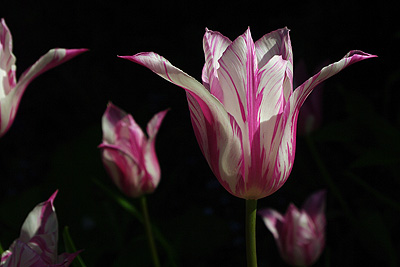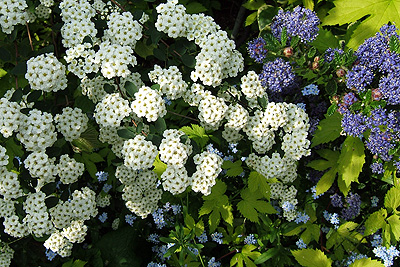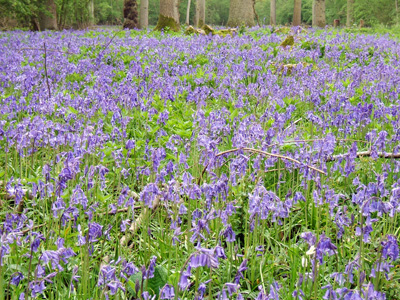The Garden in May - Jobs and Tips
plants for May
Jobs / Tips
![]() As the flowers of spring flowering shrubs fade, they
can be pruned back to get a good display next year. Forsythia,
Ribes (flowering currants), Kerria japonica, Chaenomeles
(Japanese quince) and early flowering Spirea should all
be pruned after flowering to keep them vigorous and flowering
well. Ideally each year you should cut out one in three or one
in four of the oldest braches down to ground level. In this
way, the plant always has plenty of growth left and no branch
is allowed to get old and past its prime.
As the flowers of spring flowering shrubs fade, they
can be pruned back to get a good display next year. Forsythia,
Ribes (flowering currants), Kerria japonica, Chaenomeles
(Japanese quince) and early flowering Spirea should all
be pruned after flowering to keep them vigorous and flowering
well. Ideally each year you should cut out one in three or one
in four of the oldest braches down to ground level. In this
way, the plant always has plenty of growth left and no branch
is allowed to get old and past its prime.
If you have a neglected specimen of one of these plants, then they can withstand being cut pretty much right down to the ground, though I prefer to carry out drastic renovation over at least two years. Leaving some of the more upright and further back shoots intact so as to keep the plant going rather than dependent on reserves in the roots when recovering. If you do cut it right down, then expect at least one and maybe two years before it flowers again.
![]() Lower the lawn mower height to the normal setting
now. Initial mowings in early spring should be slightly
higher than normal, after a couple the blades can be lowered.
Remember that little and often is the best way to get a really
good lawn. If you don't take much off each time, then it takes
less time to do overall.
Lower the lawn mower height to the normal setting
now. Initial mowings in early spring should be slightly
higher than normal, after a couple the blades can be lowered.
Remember that little and often is the best way to get a really
good lawn. If you don't take much off each time, then it takes
less time to do overall.
![]() Give your lawns a feed of fertiliser now, buy
a proprietary
lawn feed
and follow the instructions carefully. A commonly reported
lawn "ailment" is caused by people who over-feed their lawns
and then wonder how to deal with the dead patches. Adding some
other chemical won't help, watering to dilute the feed and the
passage of time will.
Give your lawns a feed of fertiliser now, buy
a proprietary
lawn feed
and follow the instructions carefully. A commonly reported
lawn "ailment" is caused by people who over-feed their lawns
and then wonder how to deal with the dead patches. Adding some
other chemical won't help, watering to dilute the feed and the
passage of time will.
![]() Weed, weed and thrice weed. They're coming up
thick and vigorously now, so start while they're relatively
small and you'll stop them from seeding and have a chance of
staying on top of the situation.
Weed, weed and thrice weed. They're coming up
thick and vigorously now, so start while they're relatively
small and you'll stop them from seeding and have a chance of
staying on top of the situation.
![]() Continue to protect young shoots from slugs.
Slug
control
Continue to protect young shoots from slugs.
Slug
control
![]() Push support
stakes into the ground around emerging tall
perennials. This will enable them to be supported from the
earliest opportunity and cause the least disturbance to them
when they are covered in leaves. It also helps to disguise the
supports later on as the plants grow around them.
Push support
stakes into the ground around emerging tall
perennials. This will enable them to be supported from the
earliest opportunity and cause the least disturbance to them
when they are covered in leaves. It also helps to disguise the
supports later on as the plants grow around them.
![]() Plant up containers and
hanging baskets with tender summer
bedding plants towards the end of the month, but don't put them
out until all risk of frost has passed. If you can't keep
them frost free, then order them in advance. If you do have
the space in a greenhouse, then such containers and baskets
are best planted up a few weeks before they are due to go out
as this allows the plants to grow into their new homes and around
each other.
Plant up containers and
hanging baskets with tender summer
bedding plants towards the end of the month, but don't put them
out until all risk of frost has passed. If you can't keep
them frost free, then order them in advance. If you do have
the space in a greenhouse, then such containers and baskets
are best planted up a few weeks before they are due to go out
as this allows the plants to grow into their new homes and around
each other.
![]() Trim quick growing hedges. They're starting to
sprout well now and it helps keep them in shape before they
get too unruly. Most hedge types can be left until early to
mid summer, but the faster growing varieties need 3 trims a
year.
Trim quick growing hedges. They're starting to
sprout well now and it helps keep them in shape before they
get too unruly. Most hedge types can be left until early to
mid summer, but the faster growing varieties need 3 trims a
year.
![]() Watch out for early signs of aphids. Mild winters mean
that more survive than in a cold one. It's about now that they
start to come out of hiding and build up their numbers. If you
can spot aphids early, then life gets an awful lot easier later
on in the year. Check the newly emerging shoots of their favourite
plants, particularly roses. My stage-one aphid eradication involves
simply rubbing them between my fingers, you'll never get them
all this way, (it's not too distasteful when there's only a
few - wipe your fingers on the grass) but it's a good way of
setting them back a couple of weeks or more. Stage-two involves
chemicals.
anti aphid
Watch out for early signs of aphids. Mild winters mean
that more survive than in a cold one. It's about now that they
start to come out of hiding and build up their numbers. If you
can spot aphids early, then life gets an awful lot easier later
on in the year. Check the newly emerging shoots of their favourite
plants, particularly roses. My stage-one aphid eradication involves
simply rubbing them between my fingers, you'll never get them
all this way, (it's not too distasteful when there's only a
few - wipe your fingers on the grass) but it's a good way of
setting them back a couple of weeks or more. Stage-two involves
chemicals.
anti aphid
![]() Spring flowering bulb care - The daffodils have all
been over for some time, as have the hyacinths, but there's
still plenty of tulips in full bloom. They don't need any cutting
off, tying up, bending over or such like. Remove the faded flowers
so that they don't start putting their energy into making seeds
and give them a good feed of double strength liquid plant food,
especially if they're growing in grass. Just the one feed will
do, no need to repeat it, give them a good soaking so that the
water gets well down to the roots. As a rule of thumb, you should
leave the top-growth after dead-heading for at least 6 weeks
after flowering before removing the foliage, longer if possible
and ideally just leave them to die down and turn brown in their
own time before removing them, this is the time that they have
to build up the energy for next years flowers.
Spring flowering bulb care - The daffodils have all
been over for some time, as have the hyacinths, but there's
still plenty of tulips in full bloom. They don't need any cutting
off, tying up, bending over or such like. Remove the faded flowers
so that they don't start putting their energy into making seeds
and give them a good feed of double strength liquid plant food,
especially if they're growing in grass. Just the one feed will
do, no need to repeat it, give them a good soaking so that the
water gets well down to the roots. As a rule of thumb, you should
leave the top-growth after dead-heading for at least 6 weeks
after flowering before removing the foliage, longer if possible
and ideally just leave them to die down and turn brown in their
own time before removing them, this is the time that they have
to build up the energy for next years flowers.
![]() Any bulbs that were in containers in the house, they
can be left in the pots and put outside in a sunny position,
water and feed them like any other container plant until the
leaves die down and then keep the bulbs in a dark, dry place
until the autumn when they can go in the soil. Don't try using
them in the same way again as you'll be disappointed, they will
probably have been prevented from flowering last year in order
to build the bulb size up to give the best performance after
you bought them. In fact next year will be a bit disappointing
even if you put them in the soil, but their second year in the
soil and afterwards will be worthwhile. Before long, they'll
be filling the garden. Pretty good value I reckon from something
that cost the same as a bunch of flowers - years and years extra
for free.
Any bulbs that were in containers in the house, they
can be left in the pots and put outside in a sunny position,
water and feed them like any other container plant until the
leaves die down and then keep the bulbs in a dark, dry place
until the autumn when they can go in the soil. Don't try using
them in the same way again as you'll be disappointed, they will
probably have been prevented from flowering last year in order
to build the bulb size up to give the best performance after
you bought them. In fact next year will be a bit disappointing
even if you put them in the soil, but their second year in the
soil and afterwards will be worthwhile. Before long, they'll
be filling the garden. Pretty good value I reckon from something
that cost the same as a bunch of flowers - years and years extra
for free.
![]() A "must buy" if you haven't already got any yet are pots of
sweet pea seedlings. They have the advantage over many similar
plants in that they're hardy and so don't need to be kept in
a greenhouse or take up huge amounts of windowsill space. They
benefit from protection though, so keep them under shelter if
you have any, or in a sheltered part of the garden if you don't
until the days start to get warmer.
A "must buy" if you haven't already got any yet are pots of
sweet pea seedlings. They have the advantage over many similar
plants in that they're hardy and so don't need to be kept in
a greenhouse or take up huge amounts of windowsill space. They
benefit from protection though, so keep them under shelter if
you have any, or in a sheltered part of the garden if you don't
until the days start to get warmer.
Put about 10-12 plants into a large container, say 18" square or diameter, arrange a wigwam of 4 x 5ft or so high canes with string across them to bridge the gaps and interplant at the bottom with 4 viola plants. Before long, the sweet peas will be up the canes hiding the wigwam and as long as you remember to dead-head, will provide you with weeks of glorious fragrant flowers.
![]() Summer bedding is particularly useful if you've a new garden
maybe with some gaps between the shrubs and perennials because
they haven't yet grown large enough. Choose larger plant varieties
and group them in 3's and 4's, as they're usually frost tender,
they'll have gone by the time the permanent residents have grown
up.
Summer bedding is particularly useful if you've a new garden
maybe with some gaps between the shrubs and perennials because
they haven't yet grown large enough. Choose larger plant varieties
and group them in 3's and 4's, as they're usually frost tender,
they'll have gone by the time the permanent residents have grown
up.
Don't plant out any frost tender plants until at least the middle of May and preferably towards the end.
If you do have any outside and it looks like a frost maybe due, then bring them in if possible to a greenhouse, cold frame or even a garage or shed over-night.
![]() Don't cast any clouts before the end of the month.
There's an old English phrase "N'ere cast a clout 'ere May
is out". Which is well known but the meaning a bit obscure.
It originates in Lancashire where "clout" means clothing (as
well as a smack) and the "May" is not the month of May, but
the Hawthorn which flowers in May along the hedgerows and so
is often called May itself. So it means don't cast off any clothing
until the hawthorn blossoms (not until the end of May) - or
make sure you still keep your winter underwear on until later
than you'd think.
Don't cast any clouts before the end of the month.
There's an old English phrase "N'ere cast a clout 'ere May
is out". Which is well known but the meaning a bit obscure.
It originates in Lancashire where "clout" means clothing (as
well as a smack) and the "May" is not the month of May, but
the Hawthorn which flowers in May along the hedgerows and so
is often called May itself. So it means don't cast off any clothing
until the hawthorn blossoms (not until the end of May) - or
make sure you still keep your winter underwear on until later
than you'd think.
Copyright 2000 - present. All Rights Reserved | Privacy Policy Statement






